The most famous structures in the Umayyad style are the Great Mosque in Damascus, the Dome of the Rock and the Great Mosque in Cordoba. The Umayyad Dynasty is the “first” dynasty of the New Islamic World.
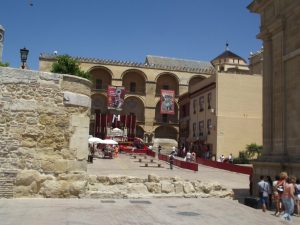
Image source: https://search.creativecommons.org/photos/6c81ea5a-7ca3-4a38-b3df-2e7195193c4b
How did the Umayyad dynasty start?
The Umayyads style gets its name from the dynasty that is responsible for its creation. The Umayyads, headed by Umayya ibn Abd Shams in the pre-Islamic period, were the families of the Quraysh tribe centered at Mecca. Umayyad rule had two branches: the Sufyanids and the Marwanids. After the death of the Prophet Muhammad in 632 C.E., they started the Rightly Guided Caliphs. Under their strict command, the Arab armies carried the new conquest from Arabia to the shores of the Mediterranean. During Mu‘awiya’s reign (661–80) Islamic power transferred from the Arabian Peninsula to Syria. Under Mu‘awiya’s reign, the city of Damascus transformed into the capital of the empire. This new empire extended from the Indus River to the Atlantic Ocean and marked the beginning of the Umayyad dynasty.
The art of the Umayyad dynasty
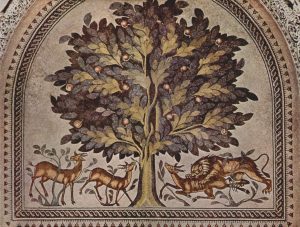
Image source: https://en.wikipedia.org/wiki/Umayyad_architecture
The Umayyad epoch is one of the most productive periods in Islamic art. While Islam became the principal religion and Arabic the official language, artists continued to work in their traditional manner. The artistic influence came from the antique classical tradition. This ideology had been prevalent on the eastern shores of the Mediterranean, and especially affected textiles, metalwork, and the depiction of animals, and figures. During this period artists developed new forms, techniques, and creative customs. The artistic adaptation gave way to a new artistic expression that was distinctly Islamic.
The art of Umayyad period in Spain (711–1031)
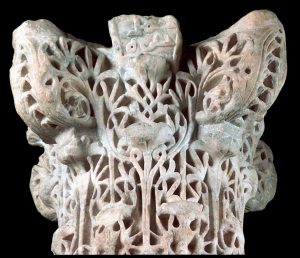
Image source: https://search.creativecommons.org/photos/7ca059e9-b5ac-416f-b4d0-7d95c2e35073
Abd al-Rahman I arrived in Spain in 756 and established the Islamic capital there. In Cordoba, they began a revival of the Umayyad period in response to Mediterranean cultural impulses. A form of nostalgia developed of the time when the Umayyads ruled the Islamic world. Many philanthropists from abroad came forward to showcase authority and kingship. Luxurious objects such as bronze animal statues, boxes of gilt silver and carved ivory, and splendid silks were commissioned for many wonderful palaces. Some artwork was decorated with stucco wall panels, ornate marble capitals, and marble fountains.
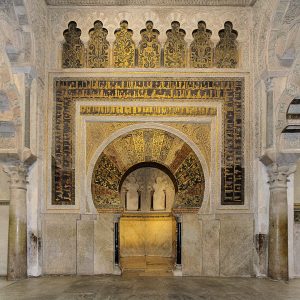
Image source: https://en.wikipedia.org/wiki/Mosque%E2%80%93Cathedral_of_C%C3%B3rdoba#The_mihrab_and_the_maqsura_of_the_mosque
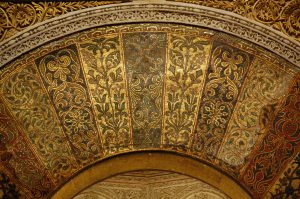
Image source: https://en.wikipedia.org/wiki/Mosque%E2%80%93Cathedral_of_C%C3%B3rdoba#/media/File:Cordoba_Mosque_07.jpg
A room-sized mihrab, in the Great Mosque, was installed by Al-Hakam II between 961 and 976. It was decorated with colored mosaics created by Byzantine artists and interspaced with carved stucco. This design represented the visual celebration of both the material and spiritual triumph of the Islamic religion.
Architectural achievements of the Umayyad empire
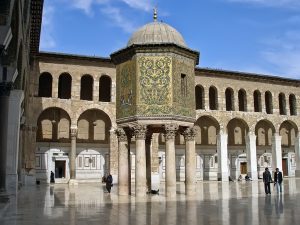
Image source: https://en.wikipedia.org/wiki/Umayyad_Mosque
The Umayyad styel was critical in the development of Islamic architecture. The necessities of the new religion and customs demanded a different usage of space. The Umayyads often constructed their monuments on symbolic or historical sites. For example, The Dome of the Rock in Jerusalem was built on a site formerly occupied by Solomon’s Temple and related to Muhammad’s ascent to heaven.
Another religious building includes the enlarged mosque in Medina, the former house of Muhammad. Another paramount site representing this style is the Mosque of the Umayyad capital Damascus. This site was formerly a Roman Temple, but it was converted into a Mosque as a sign of Islamic religious and political domination.
Info source:
https://en.wikipedia.org/wiki/Umayyad_architecture
https://www.britannica.com/topic/Umayyad-dynasty-Islamic-history
https://www.khanacademy.org/humanities/art-islam/chronological-periods-islamic/islamic-art-early/a/the-umayyads-661749-ce
https://www.metmuseum.org/toah/hd/umay/hd_umay.htm
https://www.phaidon.com/agenda/art/articles/2013/december/23/the-art-of-umayyad-period-spain/
